Mosaics in North and Central Vietnam
by Richard Davis, Clinton, WA richarddavismosaics.com
This article is extended from the Fall 2012 issue of Groutline – SAMA’s e-Journal available for members.
The two-mile long mosaic mural in Hanoi, Vietnam that has recently entered the Guinness World Records as the world’s longest mosaic mural would seem to indicate that Vietnam has a long history of mosaic art. During a recent trip there I found this not the case.
Hue’s Imperial City
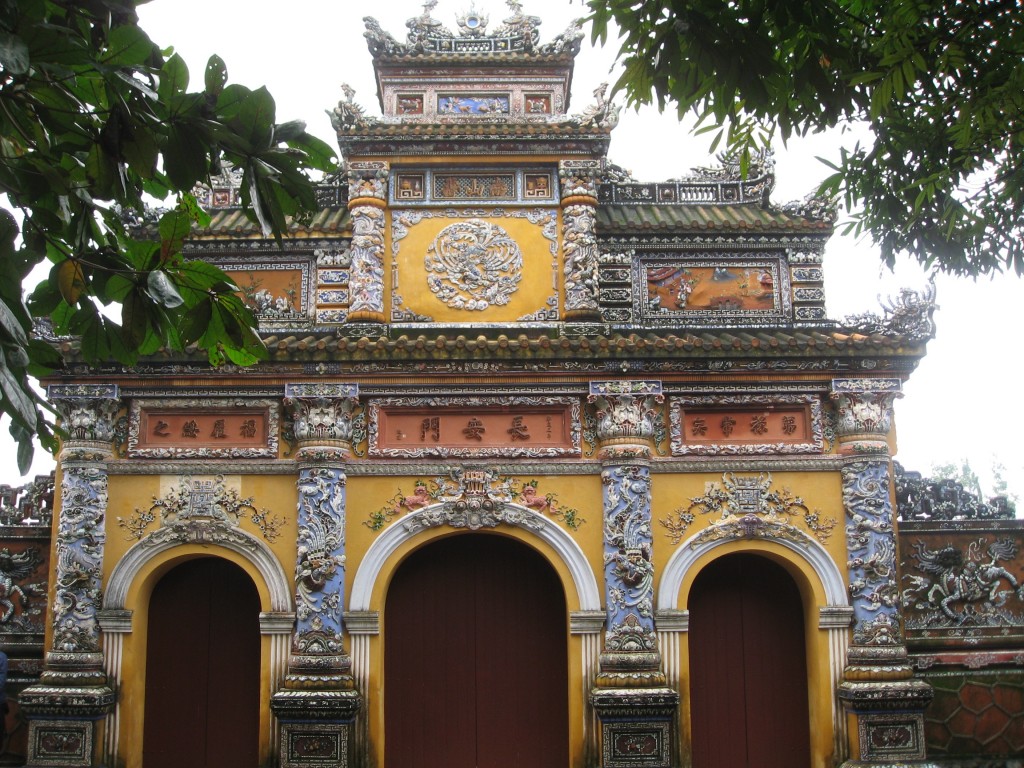
Hue Citadel
The oldest mosaics I found in Vietnam were in the Imperial City in Hue. These were constructed over many years beginning in 1805. Since the Imperial City has suffered greatly from the ravages of war, weather, and repairs, it’s difficult to know the ages of the mosaics to be currently found in the Royal Theatre, Bien Tho Palace Gate, and other structures. On these buildings, as elsewhere in Vietnam, mosaic images are made with any of the following: plaster and/or cement, paint, ceramic tile, porcelain pottery, and bottle glass. Mosaics generally take the form of bas-relief or three-dimensional objects.
Mosaic of Emperor Khai Dihn
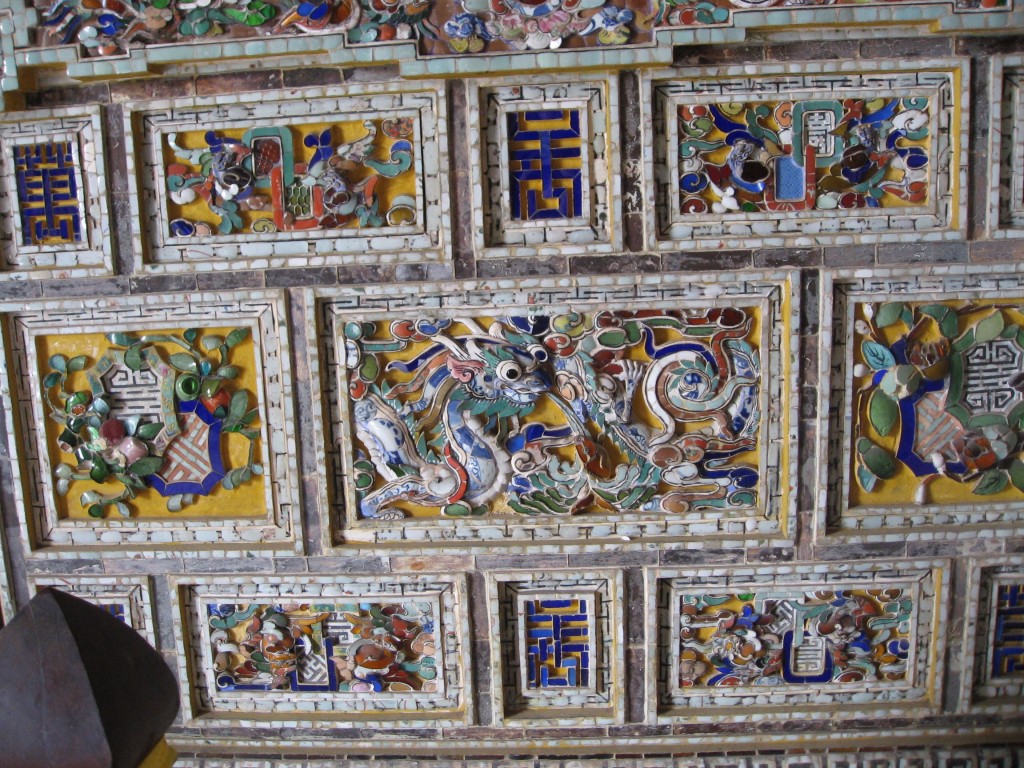
Khai Dinh Tomb
Probably the most famous “old” mosaic in Vietnam is the tomb of the Emperor Khai Dinh (reigned 1916-1925) located in the countryside outside of Hue. The tomb was built from 1920-1931 and was so elaborate that taxes in Vietnam had to be increased by 30 percent to pay for it. I estimated the three main chambers of the mausoleum to be each 20 feet tall, and at least 350 square feet each in size. The mosaics stretch from floor to ceiling on every wall and on the tomb dais itself. Background walls are dyed either a creamy yellow or a peachy skin pink. A layer of clear glass cut in trapezoidal shapes and placed vertically in a herringbone style pattern covered the painted walls. Images on these walls are either flat, partially bas-relief by reason of their projecting materials, or are truly bas-relief by virtue of built-up forms of plaster and/or cement. Finer details, such as leaves or tassels, are usually made with green or brown cut bottle glass. In addition, judicious use of the patterns on the broken porcelain pottery along with paint and the dyed plaster and/or cement helps to emphasize shapes. As best I could determine, mosaic materials appear to have come from France, China, and Japan.
An Bang’s City of the Dead
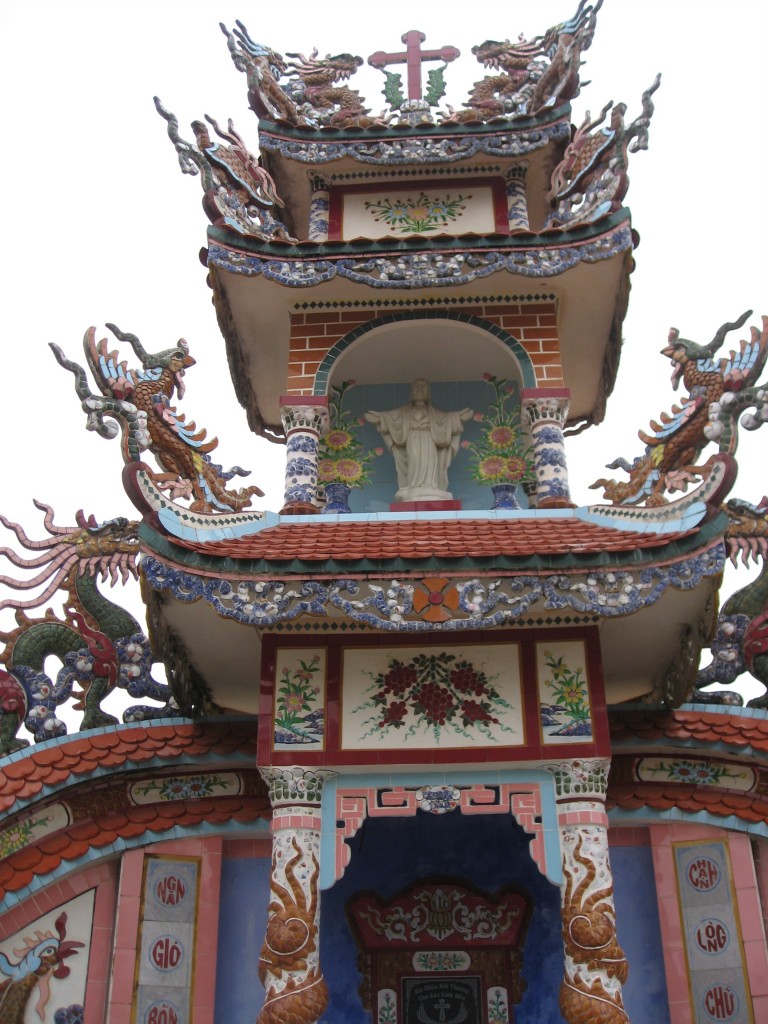
An Bang Christain tomb
Khai Dinh’s tomb architecture and mosaics appear to have influenced the construction of a cemetery of a nearby fishing village, An Bang, located about 30 miles south of Khai Dinh’s tomb on the coast. From my research it appears that this village has the most ornate private and expensively constructed tombs in all of Vietnam, with one tomb rumored to have cost $750,000!
An Bang and its cemetery are unofficially referred to as the “City of the Tombs” or “City of Ghosts.” Stretching for more than a mile along the road, the cemetery contains at least 500 freestanding family mausoleums, most of which are covered in mosaics. According to locals with whom I spoke in Hue, the money to build, decorate, and maintain these tombs has come from former Vietnamese “boat people” who have returned or sent money back to their home country since détente in 1989. Their desires were simple: to rebuild their family tombs to honor their ancestors. So-called “boat people” began leaving after the capture of Saigon by the North Vietnamese in 1975. Thousands more attempted harrowing sea escapes for years afterwards.
The mosaic-filled graveyard at An Bang demonstrates just how important the veneration of one’s ancestors is in Vietnamese culture, no matter which religion is practiced by the family.
Because I arrived in An Bang late in the day in January, I was able to spend only about 30 minutes here before sunset ended my visit. Consult the websites at the end of this story for better images and more information about this fantastic place. (Please don’t confuse this small village of “An Bang” with the similarly named “An Bang Beach” near Hoi An, which is also in Central Vietnam.)
Hanoi’s Commemorative Mosaic
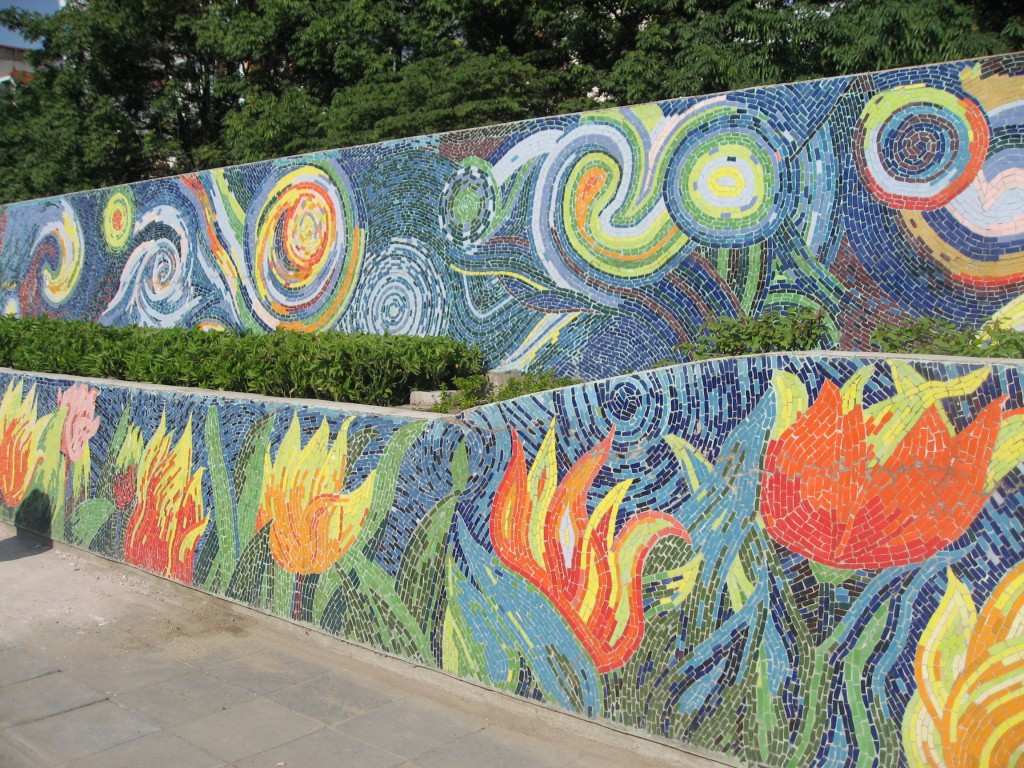
Hanoi Mural Van Gogh international contribution
The longest mosaic in the world at over two miles long is in Hanoi. Work on it began sometime in 2006 or 2007 in commemoration of 1,000 years of Hanoi history. It was created over a period of three years with the help of many artists and volunteers. Although the height of the wall varies, the average is about nine feet. There is no apparent overall style or theme, yet the mosaics appear unified because most are constructed with locally made ceramic tiles, with the exception of portions made by foreign artists.
Depending on the section one is viewing, themes do emerge. Many of the mosaic sections celebrate local crafts and important moments in Hanoi’s history. Mosaics in the northernmost end tend to reflect a more international outlook on the world. This section contains contributions of many non-nationals. One such area is made to replicate Van Gogh’s painting style. Along this traffic-filled corridor, human figures, plants, and animals of many varieties are to be found, as are architectural forms of many types.
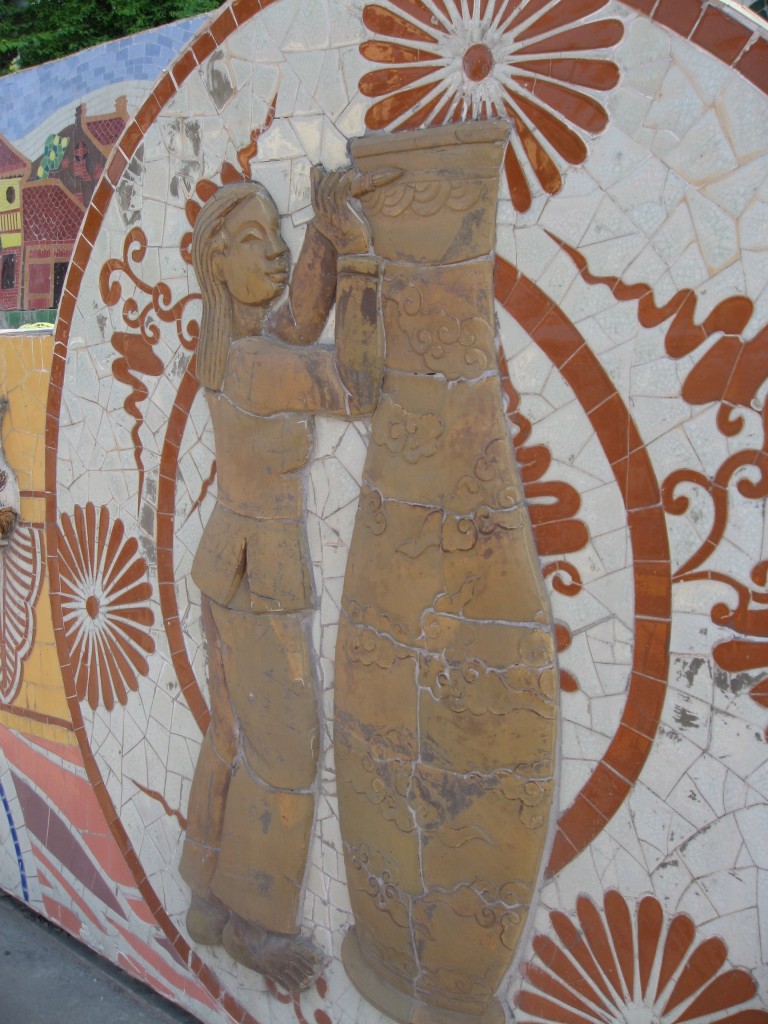
Hanoi Mural: large pottery pieces in mosaic
Generally, the mosaic wall sections are mostly flat, with occasional embellishments of larger, thicker pieces of fired pottery. Paint and dyed substrate were not used for emphasis.
Hanoi’s mosaic mural stretches along a very busy and chaotic four-lane road. It’s very difficult to photograph because there is no vantage point for photography that doesn’t in some way place one in danger of being run over, skewered by a bamboo pole carrying goods to market, or bashed by a cage of pigs or ducks! Many of the photos one can find of the mural are shot at extreme angles because this is as far from the mosaic as one can safely get!
The installation conditions of the mosaic must have been difficult in the extreme, especially since artists would not have had the ability to back up to check image resolution and perspective. For work made in the indirect method, which may well have been the way much of the mural was made, this would not have been a particularly vexing issue.
To see the mosaic well, one can walk its length on a narrow, five-foot wide sidewalk. Alternately the viewer can slowly drive or be driven along the length. This activity is hazardous in itself since one’s car must dodge endless bicycles, motorcycles, cars, and trucks all weaving in and out around your vehicle. Overall, the effect of viewing the entire length of the project is similar to seeing a slide show without a dissolve between images—one discreet image following the next. To read more about the Hanoi Mural, visit hanoimural.vn and read the various entries under the “Category” menu.
Nguyen Hong Tan, Mosaic Artist
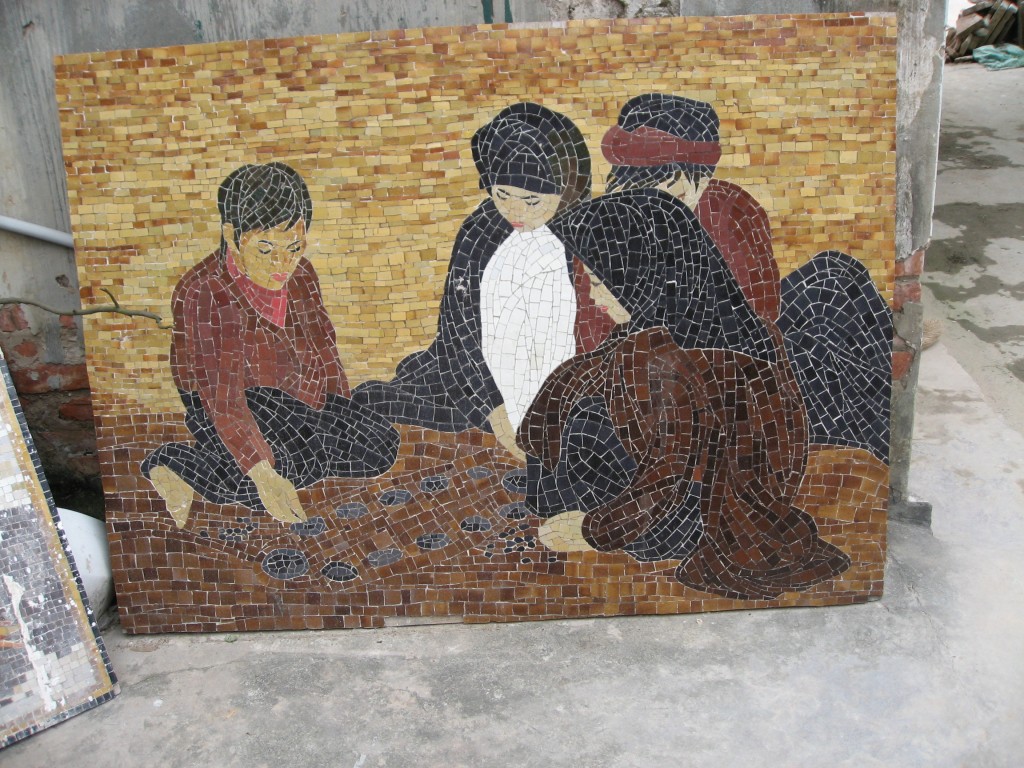
Nguyen Hong Tan: Vietnamese painting copy
I was fortunate to visit one of the potteries (Cong Ty Tnhh Gom Chi) responsible for making some of the millions of tiles used in Hanoi’s commemorative mosaic. Located in Hanoi’s suburbs, the pottery is run by three sons of the original founder and employs up to 100 people making everything from teapots to tiles. One of the sons, Nguyen Hong Tan, is a mosaic artist in his own right. He explained to me that there is very little appreciation for mosaics in Vietnam as an appropriate material for fine art rather than just as a decorative surface technique allied to architecture. Nguyen began his career by studying art and developed his own mosaic work as a sideline to his parents’ pottery business.
With his permission I took photographs of the mosaic “copies” he has made of famous Western and Vietnamese paintings that decorate the entrance to the pottery. (It’s not unusual for Vietnamese artists to copy Western artworks in any medium.) His clients are generally wealthy Hanoi residents who are building or remodeling homes. Nguyen appears to deal almost exclusively with site-specific installations, of which he is both the designer and chief installer. I was shown photographs of some of these projects but was not able to visit the installations in person.
Outside Outsider Art
A typical middle-class Vietnamese home is usually several stories tall and narrow, often no more than one room wide. The street-level floor and courtyard are frequently home to a business of some kind. This level often contains indoor and outdoor cooking and washing areas and more often than not, large trees or other plants in pots. Motorcycles and cars are pulled into the patio area just inside the door or gate.
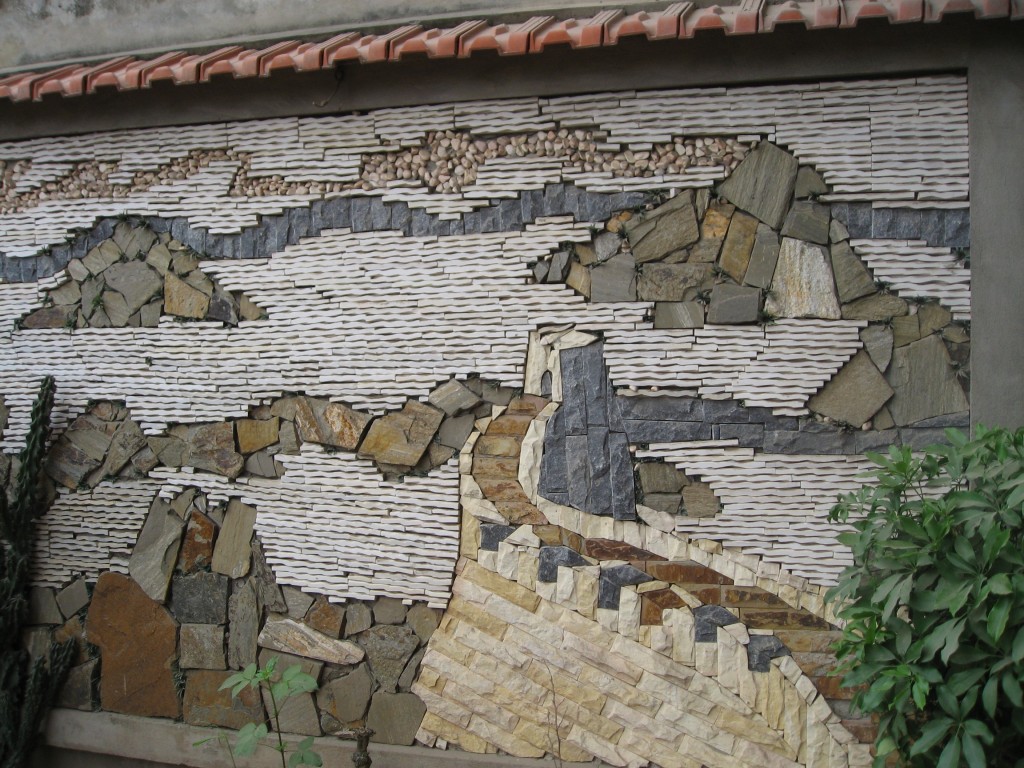
near Phat Diem Cathedral Made by mineral explorer, Great Wall Of China
Quite by accident, I discovered and interviewed (with the help of an able translator) two individuals who had created their own mosaic installations in their courtyards. One home featured a mosaic of stones and pebbles collected by the owner during a career of mineral exploration in the mountains. This artwork features an image of the Great Wall of China among other elements. He told me he created the mosaic to remind him of his past experiences in the mountains, as he now lives in the flat Mekong River Delta.

Bui Ngoc Mo
The other mosaic owner I interviewed, Bui Ngoc Mo, is an artist of a completely different order. He had spent many years creating a courtyard installation. Filled with creatures set in mystical landscapes, his creation reminded me of the “outsider” art of Ferdinand Cheval’s Les Palais Idéal in Hauterives, France. Hgoc Mo seemed genuinely pleased to have his work admired by someone other than his family. He uses cement, plastic figures, ceramic figures, dishes, shells, stones, and found objects to create his installations. The main “highway” outside his home is dirt, so the installation is covered in a fine layer of brick-red dust.
Below are links to a more detailed history of An Bang with excellent photos and the webpage link to the Hanoi Mosaic Mural.
If you are looking for a mosaic-filled vacation with good food and friendly people, consider Vietnam the next time.
http://english.vietnamnet.vn/social/2006/09/610460/
http://en.www.info.vn/explore-vietnam/destination/25967-an-bang-city-of-ghosts-.html
Image Gallery
click on any image to begin slideshow
all images ©2012 Richard S. Davis

